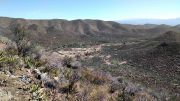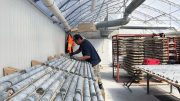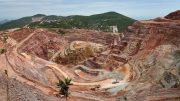79North’s (CSE: JQ; US-OTC: SVNTF) first six diamond drill holes into the Witlage target at its Nassau gold project in Suriname hit high-grade mineralization in near-surface oxidized saprolite and in hydrothermally altered volcanic rock.
Drillhole NP-21-15 returned 383.20 grams gold per tonne over 1.5 metres from 33 metres downhole (saprolite with quartz veins), and drillhole NP-21-16 cut 99.58 grams gold per tonne over 1 metre from 83 metres downhole (fresh bedrock).
“We drilled holes in areas that we did our high-grade surface sampling and we got these really excellent results,” Jon North, the junior explorer’s founder and CEO, said in an interview.
North is convinced that the company has found the source for all the placer gold in the area that has been and continues to be mined by artisanal miners.
“People have been mining gold in alluvium there for over a hundred years according to local legend and there are still people mining there right now today near or where we’re drilling,” he says. “But this is the first time anyone has intersected high-grade source rocks in all that’s been going on there for a century, so all we can say is that we’ve proven that the source material is there and what we intersected is completely different than what they’re mining because we’re way below the alluvium. So we have to demonstrate that this is the bedrock gold deposit that is the source for all the gold in the placers, which it is, for sure it is.”
North estimates that placer mining in the Witlage area has taken place over a vast area running “probably several kilometres long and a couple of kilometres wide.”
The drill results exceeded even his expectations, however, and confirm his view that the company is dealing with a “potentially large gold-bearing system, potentially associated with a mineralized oxide blanket.”
The plan now is to source a drill rig and follow up on the results with a drill pattern near the collars and possibly with a reverse circulation drill rather than a diamond drill. “The oxide zone is basically from at surface, covered with some clay zones, and it’s within 25 metres of surface,” he says, “and high-grade intersections we hit—the 100 grammers—are about 70 metres vertical, so it’s all near-surface and there’s lots of other hits within 50 metres of surface.”
This year the company will do about 2,000 metres of drilling or a minimum of 20 RC drill holes.

CEO Jon North at 79North’s Nassau project in Suriname. Credit: 79North
But North is the first to admit that working in remote parts of Suriname isn’t always easy. “Drilling in 2021 went very, very, slowly because we were operating in difficult conditions,” he says. “We were operating on our own jungle roads to bring in drill rigs. These aren’t mountains, but when it’s raining hard these are hills covered in greasy clay. It’s tough moving around in there, it’s tough walking in there. But that’s just the nature of Suriname and the Guyana Shield, so we can’t cry about it, that’s the way it is.”
The 2021 drill program was also divided between two different targets, both of which are on northwest trending structures. The company drilled six holes (539.50 metres) at Witlage and 12 holes (1,472.73 metres) at Carbonara, about 5 km away. The drilling at Carbonara, however, did not produce the results North was hoping for and the company shifted its focus to Witlage.
“We got the results from Carbonara and we saw the alteration zone, the rocks were beautiful, we saw alteration we hadn’t seen at surface … but the results just weren’t very good and we felt we tested it with enough drill holes and there was nothing else to do at Carbonara,” North says. “We kissed that frog and it’s not a prince.”
The 20,000-hectare Nassau project is about 20 km south of Newmont‘s (TSX: NGT; NYSE: NEM) Merian gold mine and 60 km east of Iamgold‘s (TSX: IMG) Rosebel gold mine.
North who has worked all over the world, says what he has seen so far at the Witlage target is comparable in some respects to the Yaramoko gold deposit, which Roxgold developed before the company was acquired by Fortuna Silver Mines (TSX: FVI; NYSE: FM) for $1.1 billion last year. The gold deposit in Burkina Faso lies in Birimian rocks, North says, which are the same age as the rocks in Suriname. “Yaramoko isn’t a huge deposit, but it’s nice; it produces about 100,000 oz. a year at 10-12 grams gold per tonne.”
Another project he thinks is similar in terms of Witlage’s saprolite component, is Cabral Gold’s (TSXV: CBR; US-OTC: CBGZF) MG and Central gold deposits in Brazil’s Cuiu Cuiu gold district. “They are oxide deposits and have underlying hypo-gene intersections as well,” North says. “They are very very interesting deposits because they’re oxide, and flat-lying and near surface. We’ve got the same thing: we’ve got mineralized material in oxidized saprolite and we also have good hits in the underlying rocks.”
79North’s shares closed 1.5¢ higher or 18.75% on news of the drill results and finished the day at 9.5¢. Over the last year the junior has traded in a range of 8.5¢ and 16¢ per share. The company has about 91.6 million common shares outstanding for a market cap of about $8.7 million.






Be the first to comment on "79North hits high grade at Nassau project in Suriname"